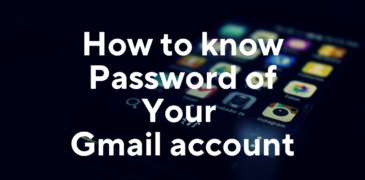Imagine waking up one morning, excited to check your emails, only to discover that you are locked out of your Gmail account. Panic sets in as you realize you can’t remember the password you’ve been using for years. This frustrating situation is one that many of us have encountered. But don’t worry! In this article, we will provide a step-by-step guide on how to recover your Gmail account password, ensuring that you regain access to your treasured emails, essential contacts, and valuable information.
Gmail, Google’s popular email service, has become an indispensable part of our digital lives. It holds our personal conversations, memories, and a wealth of crucial information. Protecting the security of your Gmail account is of utmost importance, but sometimes, despite our best efforts, we find ourselves locked out due to forgotten passwords. Thankfully, Google has provided a range of options and tools to help you regain access to your account swiftly and securely.
In this article, we will delve into the world of Gmail password recovery, providing you with practical and actionable steps to reclaim your account. We’ll cover everything from creating a strong password to enabling two-factor authentication for enhanced security. You’ll also discover the various recovery methods offered by Google, ensuring that you have multiple avenues to retrieve your account in case of a lockout.
Choosing a Strong Password
Creating a robust password is the first line of defense against unauthorized access. Consider the following tips when selecting a password:
- Length and Complexity: Opt for a password that is at least eight characters long, combining uppercase and lowercase letters, numbers, and symbols.
- Avoid Common Phrases and Personal Information: Do not use easily guessable passwords such as your name, birthdate, or commonly used words.
- Randomness: Utilize a combination of unrelated words or use a reputable password manager to generate a unique, random password for each account.
- Regular Updates: Change your password periodically to minimize the risk of a breach.
Enable Two-Factor Authentication (2FA)
Adding an extra layer of security through 2FA significantly enhances the protection of your Gmail account. Here’s how to enable it:
- Access your Gmail account settings and locate the “Two-Factor Authentication” or “2-Step Verification” option.
- Follow the instructions to choose a second factor, such as a text message, phone call, or authentication app, to verify your identity during login.
- Each time you sign in to your Gmail account, you will need to provide the secondary verification code or response from your chosen method.
Regularly Update Recovery Information
Maintaining up-to-date recovery information is crucial in case you ever lose access to your account. Take the following steps to ensure your recovery information is accurate:
- Visit your Google Account settings and navigate to the “Security” section.
- Verify and update your recovery email address and phone number.
- Additionally, consider adding a secondary email address and enabling recovery prompts for extra account recovery options.
Password Recovery Option
Even with precautions, it’s possible to forget or lose your Gmail account password. Here are some methods to recover your password:
- Forgot Password: On the Gmail login page, click on the “Forgot password?” link. Follow the on-screen instructions, provide necessary account information, and choose a recovery method (email, phone, or security questions) to regain access.
- Account Recovery Form: If you are unable to access your recovery email or phone number, Google offers an Account Recovery Form. Fill out the required details, such as previous passwords, associated Google services, and approximate account creation date, to help verify your identity and recover your account.
- Account Recovery for Inactive Accounts: If your Gmail account has been inactive for a long period, Google might have marked it as dormant. In such cases, you can attempt recovery by signing in and following the provided instructions.
Preventing Phishing Attacks
Phishing attacks aim to trick users into revealing their passwords and other sensitive information. Safeguard your Gmail account by following these guidelines:
- Be vigilant with emails: Avoid clicking on suspicious links or downloading attachments from unknown senders.
- Verify website authenticity: Double-check the URL to ensure you are on the genuine Gmail login page (https://mail.google.com).
- Never share your password: Gmail will never ask you for your password via email or phone. Be cautious of any unsolicited requests for your login credentials.
Monitoring Account Activity
Staying informed about your Gmail account’s activity can help you identify any suspicious behavior. Google provides tools to monitor your account:
- Account Activity: Check the “Recent activity” section in your Gmail settings to view the devices and locations where your account has been accessed.
- Security Alerts: Enable security alerts to receive notifications about unusual or suspicious activity on your Gmail account.
- Account Permissions: Periodically review and revoke access for any third-party applications or services that you no longer use or trust.
Also read:
Should you use PowerPoint or Google Slides?
How to Transfer and Sync Data Dropbox to Google Drive?
DA 30+ Free Do Follow Social Bookmarking Sites List 2020 ( July Updated)
Four Super Tips to Make Money With Websites
FAQs
I forgot my Gmail account password. How can I recover it?
If you’ve forgotten your Gmail account password, you can initiate the password recovery process by clicking on the “Forgot password?” link on the Gmail login page. Follow the prompts, provide the necessary account information, and choose a recovery method (email, phone, or security questions) to regain access to your account.
What if I don’t have access to the recovery email or phone number linked to my Gmail account?
If you no longer have access to the recovery email or phone number associated with your Gmail account, you can still attempt to recover your account. Google provides an Account Recovery Form where you can provide details such as previous passwords, associated Google services, and the approximate date of account creation. This information will help verify your identity and recover your account.
Can I recover my Gmail account if it has been inactive for a long time?
Yes, you can attempt to recover an inactive Gmail account. However, if your account has been dormant for an extended period, Google may have marked it as inactive. In such cases, you can try signing in to your account and follow the instructions provided to regain access. If you encounter difficulties, you can also contact Google support for further assistance.
Are there any other methods to recover a Gmail account password?
Apart from the standard password recovery process, Google offers additional methods for account recovery. These include using the Google Authenticator app or backup codes associated with your account. It’s recommended to set up these options in advance to ensure a smoother recovery process.
How can I prevent unauthorized access to my Gmail account in the first place?
To prevent unauthorized access to your Gmail account, it’s essential to choose a strong and unique password. Enable two-factor authentication (2FA) to add an extra layer of security. Regularly update your recovery information, including your email and phone number. Stay vigilant against phishing attempts and avoid sharing your password with anyone.
What should I do if I suspect my Gmail account has been compromised?
If you suspect that your Gmail account has been compromised, act quickly. Change your password immediately and enable two-factor authentication. Review your account activity for any suspicious behavior and revoke access for any unrecognized third-party applications. Contact Google support if you need further assistance in securing your account.
Can I recover deleted emails if I regain access to my Gmail account?
If you recover access to your Gmail account, you should be able to retrieve deleted emails as long as they haven’t been permanently deleted from the Trash folder. Deleted emails usually remain in the Trash folder for 30 days before they are permanently erased. However, it’s always recommended to back up important emails to prevent data loss.
Conclusion
Ensuring the security of your Gmail account is vital for safeguarding your sensitive information and upholding your online privacy. By incorporating robust password strategies, activating two-factor authentication, and remaining vigilant against phishing attacks, you can substantially diminish the chances of unauthorized entry into your account. Moreover, it is essential to acquaint yourself with the account recovery alternatives offered by Google, guaranteeing that you can regain control of your account if the need arises. By adhering to these principles, you can relish a Gmail experience that is both secure and protected.







